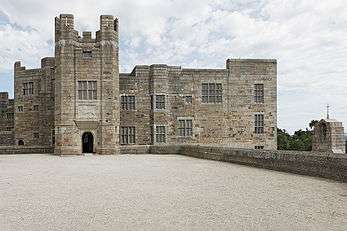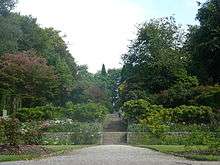Castle Drogo
| Castle Drogo | |
|---|---|
 | |
| General information | |
| Type | English country house |
| Location | Drewsteignton, Devon, England |
| Coordinates | 50°41′46″N 3°48′41″W / 50.6960°N 3.8114°WCoordinates: 50°41′46″N 3°48′41″W / 50.6960°N 3.8114°W |
| Construction started | 4 April 1911 |
| Completed | 1930 |
| Renovated | 2013–2017 |
| Client | Julius Drewe |
| Owner | National Trust |
| Design and construction | |
| Architect | Edwin Lutyens |


Castle Drogo is a country house and castle near Drewsteignton, Devon, England. It was built from 1911 to 1930 for Julius Drewe (businessman and founder of the Home and Colonial Stores) to designs by architect Edwin Lutyens, and is a Grade I listed building. It is currently undergoing a five-year conservation project (2013–2017) to finally make it watertight.[2] It was the last castle built in England. The gardens are Grade II* listed in the National Register of Historic Parks and Gardens.[3]
Background
In 1910 Julius Drewe bought about 450 acres (1.8 km2) south and west of the village of Drewsteignton in the belief that he was descended from the Drewe family that once lived here. (By the time of his death in 1931 he had bought up an estate of 1,500 acres). He then asked Edwin Lutyens to build him a castle. According to his son Basil, he did so on the advice of Edward Hudson, proprietor of Country Life magazine, who was both a patron and a champion of Lutyens. Drewe was now 54 years old, but he still had time, energy and money to create his new family seat. On 4 April 1911, Drewe's 55th birthday, the first foundation stone was laid.[4]
Construction
The castle took many years to complete, with the First World War and the economic downturn causing many delays. Castle Drogo was finally completed in 1930, roughly half the size of Lutyens's 1911 designs, and only a year before Julius died; he had, however, been able to live in the house since around 1925. It was built coterminous with Lutyens' work in New Delhi resulting in many similarities in design.
Features
The stately home borrows styles of castle building from the medieval and Tudor periods, along with more minimalist contemporary approaches. A notable feature is the encasement of the service staircase, around which the main staircase climbs. Its defensive characteristics are purely decorative. Additionally, the castle had electricity and lifts from the outset, with power being supplied by two turbines on the river below.
Gardens

The castle has a fine formal garden, designed by Lutyens with planting by George Dillistone, which contrasts effectively with its striking setting on the edge of Dartmoor. The garden is noted for its rhododendrons and magnolias, herbaceous borders, rose garden, shrub garden and circular grass tennis court now used for croquet.
Later use
After Julius's death, his wife Frances and her son Basil continued to live at the castle. During 1939–45, Frances and her daughter Mary ran the house as a home for babies made homeless during the bombings of London.
Frances Drewe died in 1954 and Basil was then joined at Drogo by his son Anthony and his wife. In 1974, Anthony and his son, Dr Christopher Drewe, gave Castle Drogo and 600 acres (2.4 km2) of the surrounding land to the National Trust. It was the first 20th-century property the charity acquired.[5] A new visitor centre with shop and café opened in the summer of 2009, after English Heritage required that industrial kitchen equipment such as that used by the previous café within the house, be removed from Grade I listed buildings. In February 2011, the National Trust launched a public appeal for money to fund necessary restoration work.[6]
Gallery
 Chapel & Garden from north
Chapel & Garden from north Chapel belfry
Chapel belfry Chapel & south façade of house
Chapel & south façade of house Chapel & south-west façade of house
Chapel & south-west façade of house West Facade
West Facade Library
Library
See also
References
- ↑ Burke's Genealogical and Heraldic History of the Landed Gentry, 15th Edition, ed. Pirie-Gordon, H., London, 1937, p.643
- ↑ National Trust | Castle Drogo | What to see & do
- ↑ Historic England. "Castle Drogo (1000452)". National Heritage List for England. Retrieved 12 February 2016.
- ↑ The Heritage Trail | Castle Drogo Archived 24 September 2009 at the Wayback Machine.
- ↑ BBC Inside Out | Castle Drogo
- ↑ "Campaign to save the last castle built in England". The Telegraph. 10 February 2011. Retrieved 10 February 2011.
External links
| Wikimedia Commons has media related to Castle Drogo. |